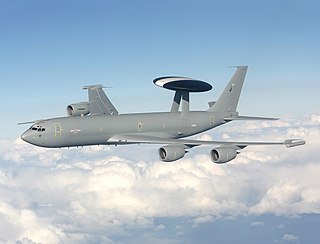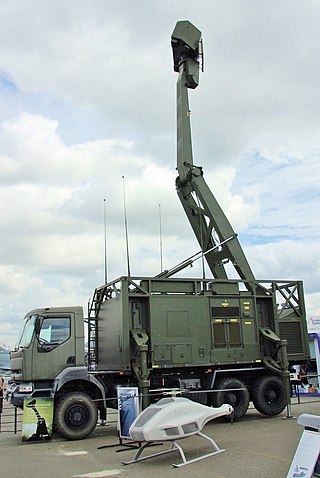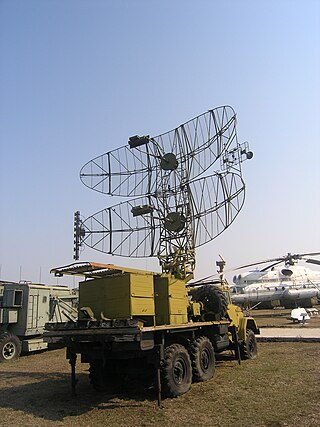
An airborne early warning and control (AEW&C) system is an airborne radar early warning system designed to detect aircraft, ships, vehicles, missiles and other incoming projectiles at long ranges, as well as performing command and control of the battlespace in aerial engagements by informing and directing friendly fighter and attack aircraft. AEW&C units are also used to carry out aerial surveillance over ground and maritime targets, and frequently perform battle management command and control (BMC2). When used at altitude, the radar system on AEW&C aircraft allows the operators to detect, track and prioritize targets and identify friendly aircraft from hostile ones in real-time and from much farther away than ground-based radars. Like ground-based radars, AEW&C systems can be detected and targeted by opposing forces, but due to aircraft mobility and extended sensor range, they are much less vulnerable to counter-attacks than ground systems.

Stealth aircraft are designed to avoid detection using a variety of technologies that reduce reflection/emission of radar, infrared, visible light, radio frequency (RF) spectrum, and audio, all collectively known as stealth technology. The F-117 Nighthawk was the first operational aircraft explicitly designed around stealth technology. Other examples of stealth aircraft include the B-2 Spirit, the B-21 Raider, the F-22 Raptor, the F-35 Lightning II, the Chengdu J-20, and the Sukhoi Su-57.

The S-300 is a series of long-range surface-to-air missile systems developed by the former Soviet Union. It was produced by NPO Almaz for the Soviet Air Defence Forces to defend against air raids and cruise missiles. The S-300 is still regarded as one of the most potent anti-aircraft missile systems in active use.

An active electronically scanned array (AESA) is a type of phased array antenna, which is a computer-controlled antenna array in which the beam of radio waves can be electronically steered to point in different directions without moving the antenna. In the AESA, each antenna element is connected to a small solid-state transmit/receive module (TRM) under the control of a computer, which performs the functions of a transmitter and/or receiver for the antenna. This contrasts with a passive electronically scanned array (PESA), in which all the antenna elements are connected to a single transmitter and/or receiver through phase shifters under the control of the computer. AESA's main use is in radar, and these are known as active phased array radar (APAR).

The Northrop Grumman MQ-4C Triton is an American high-altitude long endurance unmanned aerial vehicle (UAV) developed for and flown by the United States Navy as a surveillance aircraft. Together with its associated ground control station, it is an unmanned aircraft system (UAS). Developed under the Broad Area Maritime Surveillance (BAMS) program, the Triton is intended to provide real-time intelligence, surveillance and reconnaissance missions (ISR) over vast ocean and coastal regions, continuous maritime surveillance, conduct search and rescue missions, and to complement the Boeing P-8 Poseidon maritime patrol aircraft.

The 9K33 Osa is a highly mobile, low-altitude, short-range tactical surface-to-air missile system developed in the Soviet Union in the 1960s and fielded in 1972. Its export version name is Romb.

The United States Space Surveillance Network (SSN) detects, tracks, catalogs and identifies artificial objects orbiting Earth, e.g. active/inactive satellites, spent rocket bodies, or fragmentation debris. The system is the responsibility of United States Space Command and operated by the United States Space Force.

A counter-battery radar or weapon tracking radar is a radar system that detects artillery projectiles fired by one or more guns, howitzers, mortars or rocket launchers and, from their trajectories, locates the position on the ground of the weapon that fired it. Such radars are a subclass of the wider class of target acquisition radars.

Rajendra is a passive electronically scanned array radar developed by the Defence Research and Development Organisation (DRDO). It is a multifunction radar, capable of surveillance, tracking and engaging low radar cross section targets. It is a ground surveillance radar and is a great source of surveillance operating at frequency around 20 GHz. It is mainly used to track enemy's installations.

The S-400 Triumf, previously known as the S-300 PMU-3, is a mobile surface-to-air missile (SAM) system developed in the 1990s by Russia's NPO Almaz as an upgrade to the S-300 family of missiles. The S-400 was approved for service on 28 April 2007 and the first battalion of the systems assumed combat duty on 6 August 2007. The system complements its successor, the S-500.

The Islamic Republic of Iran Air Defense Force is the anti-aircraft warfare service branch of Iran's regular military, the Islamic Republic of Iran Army (Artesh). It split from the air force (IRIAF) in 2008 and controls the country's military radar network.

The Saab Giraffe Radar is a family of land and naval two- or three-dimensional G/H-band passive electronically scanned array radar-based surveillance and air defense command and control systems. It is tailored for operations with medium- and Short Range Air Defense (SHORAD) missile or gun systems, or for use as gap-fillers in a larger air defense system.

The P-14 is a 2D VHF radar that was developed and operated by the Soviet Union.

The P-19"Danube"1RL134 is a 2D UHF radar developed and operated by the former Soviet Union. The radar was also known by the name "Renata" in Poland and "Dunai" in the former German Democratic Republic.

The Ground Master 400 is a mobile long range radar system manufactured by Thales. GM400 is a fully digital active electronically scanned array long-range air defense 3D radar, offering detection from very high to very low altitudes. It tracks a wide range of targets from highly maneuverable tactical aircraft flying below several hundred feet to the unconventional small radar cross section devices, such as UAVs or cruise missiles.

The Krasukha is a Russian mobile, ground-based, electronic warfare (EW) system. This system is produced by the KRET corporation on different wheeled platforms. The Krasukha's primary targets are airborne radio-electronics and airborne systems guided by radar. The Krasukha has multiple applications in the Russian Armed Forces.

The AN/TPY-2 Surveillance Transportable Radar, also called the Forward Based X-Band Transportable (FBX-T) is a long-range, very high-altitude active digital antenna array X band surveillance radar designed to add a tier to existing missile and air defence systems. It has a range of 2,900 mi. Made by Raytheon, it is the primary radar for the Terminal High Altitude Area Defense (THAAD) missile system, but also cues the AN/MPQ-53 radar of the MIM-104 Patriot system. Patriot PAC-3 is a lower-altitude missile and air defense system than THAAD.

The Nebo-M or Nebo-ME also known as RLM-ME or 55Zh6ME is an integrated multi-functional radar system that features a multiple programmable multi-band design radars and a central data fusion. The radar began to be investigated in 1984. The radar complex is made up of a command post module and one to three different radars which are deployed on separate 8x8 24-ton trucks. The manufacturer claims this radar system can detect 5th generation aircraft like the F-22 and F-35 and detect long-range ballistic missile launches. Nebo-ME is an export version with some downgraded characteristics.

















